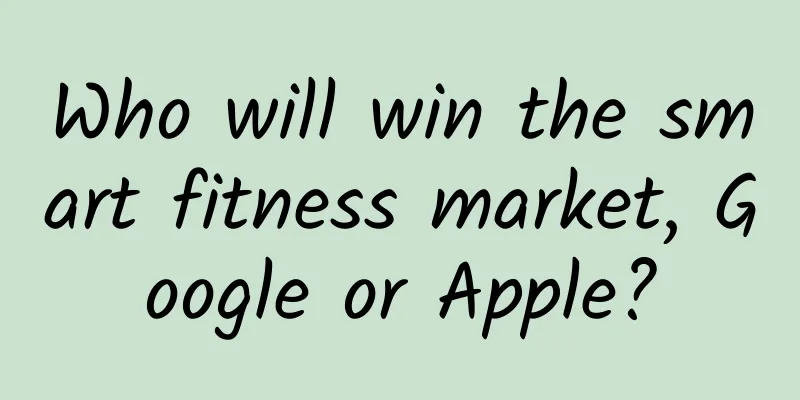Who will win the smart fitness market, Google or Apple?

|
The Apple Watch is coming on strong. The battlefields where Apple and Google are head -on seem to be growing every month: desktop OS, mobile OS, digital assistants, cloud office applications, smart watches, maps, and more . Health apps and their platforms have been one of the battlegrounds between the two companies since last fall, when Google Fit was released with Android 5.0 and Apple Health and its HealthKit API arrived with iOS 8. Now that a few months have passed, we can take a look back at how these apps and platforms performed and explore how they have further evolved since the launch of the Apple Watch. Data Collection Despite announcing a number of partners at launch, neither Apple nor Google has made much progress in third-party applications and devices. From the test results and user feedback, although there are data sources, the resources are limited and the reliability is not high. For example, the Jawbone Up app can connect directly to Apple Health, but not to Google Fit. Also, the fitness tracking app Runkeeper is available on iOS, but the Android version will be released later. In this regard, Runkeeper is one of the few apps that can provide data to both Apple Health and Google Fit. Withings, the developer of many fashionable health tracking apps on the market, has deployed its apps to be compatible with both Apple Health and Google Fit. Another health tracking app company, Misfit, only has limited support for Apple Health. Meanwhile, Fitbit currently avoids both Google and Apple's platforms. Judging from forum posts, app reviews, and our own testing, users have had a mixed experience with either platform, with some moving to more stable, established platforms like MyFitnessPal from HTC partner Under Armour to compare their tracking data. Google Fit and Apple Health have been on the market for nearly half a year, and what they have shown so far is that their potential is greater than their functionality. App Features Google Fit and Apple Health are very different in terms of functionality and operation. Google Fit is the easiest to use and has the most basic features: it tracks your activity, weight, heart rate changes, and more. Three activities, walking, running, and cycling, can be automatically recorded, and dozens of other activities, including swimming and skiing, can be added manually. Heart rate and weight data must also be added manually. The data is presented in a clear format and is integrated with many Google services. It supports daily goal achievement, but you can only add a certain number of steps or activities within a certain time each day. It can't track your sleep or give smart tips on how to change your goals or habits. Google Fit isn't as versatile as Apple's, but it still wins in areas where Google has traditional strengths: It has a web interface, can be accessed across devices, and Google has a cross-platform roadmap that suggests it will eventually support iOS (just like Gmail, Google Maps, and other services). Meanwhile, Apple Health stores all data on the running iPhone. As an app, it tracks a wider range of data than Google Fit, including sleep, distance and altitude, as well as body indicators, calories burned, blood sugar indicators and many other health data. Like Google's tool, Apple Health doesn't give you smart tips after collecting data. You can draw a chart of your sleep history, but you can't get suggestions on how to improve your sleep. Apple Health currently doesn't allow you to set health or sleep goals, but the Apple Watch has this feature. Apple Health can track the fiber content of the user's diet, the user's body temperature and many other data, while Google Fit cannot reach such a detailed level. Apple Health also has a Medical ID function, which aims to comprehensively record the user's health and medical history, while Google Fit only focuses on whether the user has achieved the goals set for the day and other functions. Mobile and Wearable Of course, with the compatibility of wearable devices such as Jawbone, Misfit, Fitbit and Withings, these are no longer necessary features, as Google Fit and Apple Health can collect data through sensors built into smartphones, and both companies have also launched their own smartwatches. For users of Android Wear smartwatches, step count and heart rate data can be seamlessly synced to Google Fit on their phones. When Apple Watch enters the market, it will surely be able to achieve seamless integration with Apple Health. Perhaps only when Google and Apple-branded wearable devices become truly popular can these apps return to their roots. In general, Google's services need more features, so this year's Google I/O developer conference is highly anticipated. Apple's services need more data sources, so the popularity of Apple Watch may benefit Apple Health more. At present, both tech giants lag behind more mature applications such as Jawbone and Fitbit. Both Google Fit and Apple Health have problems that need to be solved. It seems that both sides are tripped up in the starting blocks. As a winner of Toutiao's Qingyun Plan and Baijiahao's Bai+ Plan, the 2019 Baidu Digital Author of the Year, the Baijiahao's Most Popular Author in the Technology Field, the 2019 Sogou Technology and Culture Author, and the 2021 Baijiahao Quarterly Influential Creator, he has won many awards, including the 2013 Sohu Best Industry Media Person, the 2015 China New Media Entrepreneurship Competition Beijing Third Place, the 2015 Guangmang Experience Award, the 2015 China New Media Entrepreneurship Competition Finals Third Place, and the 2018 Baidu Dynamic Annual Powerful Celebrity. |
<<: What else can smart TVs do after video content?
>>: Is there still a chance as big players are crossing over to make mobile phones?
Recommend
The official released "Top Ten Medication Tips for the Public". Are you aware of these medication misunderstandings?
“What is a chronic disease? What are its characte...
Detailed explanation of the five major channels including Baidu, Toutiao, and Guangdiantong
Your familiarity with channels means whether you ...
Why do we feel irritable and depressed when spring comes? How to deal with these negative emotions?
There is a saying among the Chinese people that &...
Is soup a kind of "junk food"? How can we drink soup scientifically?
Soup is a nutritious and nourishing dish on many ...
Home Contact Gallery RSS Best Practices for Git in a Team -- How to Use Git Flow Correctly
We have switched from SVN to Git for many years. ...
Who is the next shooter?
Subtitle.com is caught in a contradictory situati...
Why do we always see "mosquitoes" flying in front of our eyes when we stare at a white wall?
Have you ever had this experience? Under a bright...
I recommend several H5 page creation tools, choose one for yourself!
Ever since micro scenes made with H5 became popul...
Turtle Class·Taobao Virtual No-Source E-commerce Course 5
The course comes from the 1st, 4th and 5th editio...
Chengdu tea lovers share resources, don't miss out on reliable resources
Chengdu tea lovers resource sharing appointment a...
New analysis of Tik Tok’s marketing strategy!
1. Long-term management returns to its essence In...
[Smart Farmers] The common "enemy" of humans and animals: What is the "coronavirus"?
Frequent zoonotic diseases in recent years have g...
Fliggy Product Analysis Report
After analyzing the relevant competitive products...
Things you should pay attention to when renting a server hosting provider
1. The "U" of a server is a unit that r...
The dishes you must not forget to eat in spring are delicious and nutritious, and very suitable for losing weight and controlling blood sugar!
Asparagus in spring is crisp, tender, sweet and h...









